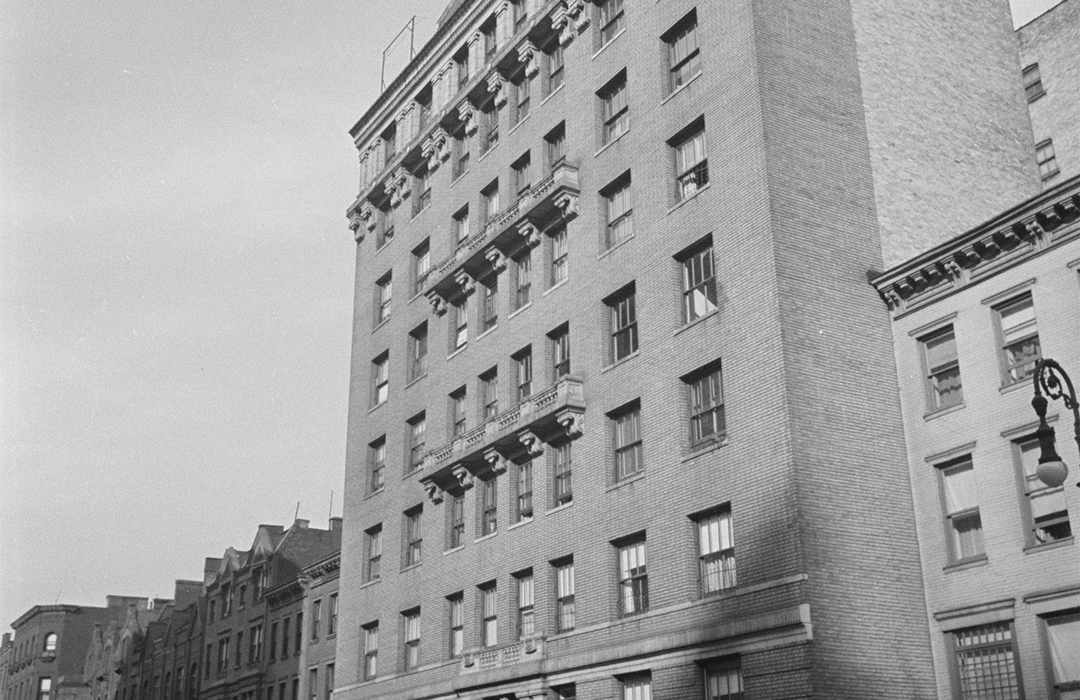
41West 83rd Street
by Tom Miller
The concept of multi-family buildings had taken firm hold within the Upper West Side by the turn of the last century. Developers were rapidly transforming the personality of the district as houses—some of them mansions and most no more than 25 years old–made way for apartment buildings. On June 28, 1912, The New York Times reported, “three more private dwellings on the upper west side will be torn down to make way for a tall apartment house.” The article said the houses at 41 through 45 West 83rd Street had been purchased the previous day by the Hennessy Construction Company.
The company hired the architectural firm of Schwarz & Gross to design the building. Costing $225,000 (or about $7.29 million in 2025), construction was completed in 1913. The architects’ neo-Renaissance, tripartite design featured an impressive, two-story entrance with paired pilasters, sumptuously carved with sheafs of fruits, flowers and nuts. Clad in gray brick, the midsection sprouted stone balconies at the fifth and seventh floors. A prominent, bracketed intermediate cornice introduced the top section, which was faced in limestone, its openings separated by paired, paneled pilasters.
Potential residents could choose from five- or six-room apartments, the larger suites including two bedrooms, two baths, and “maids’ accommodation,” according to an advertisement. Annual rents for the smaller apartments started at $900, and the six-room units at $1,400. (The more expensive rent would translate to about $3,650 per month today.)
Costing $225,000 (or about $7.29 million in 2025), construction was completed in 1913.
The tenants were affluent professionals. Among the first was William J. Clark, a partner in the American Electric Railway Association. He had begun his career in the firm 28 years earlier when it was known as the American Street Railway Association. He was also in charge of the General Electric Company’s foreign department. He started with Thompson, Houston Electric Co. on March 28, 1888, which merged with General Electric in 1892. An expert statistician, he was occasionally hired on a project basis for the U.S. Government, having been hired over the years by William F. Vilas, Postmaster General under the Cleveland Administration, by President McKinley, and Secretary of War, Russel A. Alger.
Other initial residents were Aaron and Frances Lauterbach. Aaron was a dealer in diamonds and precious stones at 170 Broadway. William H. and Hazel Williams were also early residents. Williams was a special agent in the Customs Department, and Hazel’s father was a former U.S. Representative from Kentucky. Another early tenant was Dr. Robert A. Hatcher, whose articles were routinely published in the Journal of the American Medical Association.
Two female, unmarried residents in the pre-World War I years—Florence Nightingale Levy and Esther Schiff–were what could have been deemed “modern women.” Both were highly educated and held impressive positions. Esther Schiff was an anthropologist, and Florence N. Levy was an artist, art historian, and journalist.
Born in 1870, Florence Levy received a private education before entering the National Academy of Design. Although starting out as a painter, she changed course to art history. In 1894, she went to Paris to study Italian masters at the Ecole du Louvre for a year. Upon returning, she studied under John La Farge and John C. Van Dyke at Columbia University. Levy founded the American Art Annual and was its editor until 1918. While living here, she was a staff curator at the Metropolitan Museum of Art.
Salesman Kernachan Babcock, who lived here in 1920, was also unmarried. At least he was on the evening of January 30 that year when he went to the theater. The Evening World reported that two young women who worked at Harper’s Bazaar also attended the performance, and their seats were next to Babcock’s. Helen Antisdale was an associate editor at the magazine. Her companion said to her, “Isn’t that man’s face familiar?” The Evening World recounted, “’it certainly is,’ she responded.”
Eventually, Helen Antisdale tapped Babcock on the wrist and said, “Pardon me—haven’t I seen you before?” The two realized that they had known one another in Chicago five years earlier. After the performance, they all went to Helen’s home on East 10th Street for tea. Four days later, the newspaper concluded the article saying, “And the climax to the story is this: They were married by Chief Clerk Soully at City Hall on Saturday afternoon and are now on their honeymoon.”
Her companion said to her, “Isn’t that man’s face familiar?” The Evening World recounted, “’it certainly is,’ she responded.”
By the early 1920s, Hans B. Fehr and his wife, the former Beatrice Koplile, lived at 41 West 83rd Street. Born in Germany, Fehr was educated there and in England. He was secretary, treasurer and director of L. C. Hirsch and Company, which manufactured “embossed, enameled, decorated metals and wood;” a director of the Kiddies Metal Toy Company; and several other corporations.
Another German-born resident was Julius Wolfgang Schulein. He was married to Suzanne Carvallo, a native of Paris. Both were artists. Julius was born in Munich in 1881, where he began his art studies. He moved to Paris in 1933, and he and Suzanne relocated to New York in 1941. Primarily a landscape artist, his works had been shown at the Whitney Museum of American Art, Carnegie Institute, at one-man shows at the Knoedler Galleries, and in Paris.
Suzanne Carvallo Schulein was a painter of portraits and flowers. The accomplished artist painted the portraits of Alfred Steiglitz, Bruno Walter and Thomas Mann, among others. Her works were exhibited at the Salon de Tuilleries and Salon d’Automne in Paris and the Carstairs Gallery in New York.
Julius Wolfgang Schulein died at the age of 89 in the couple’s apartment on November 26, 1970. A year-and-a-half later, on April 14, 1972, Suzanne Carvallo Schulein died here at the age of 88.
The configuration of the apartments has not been altered since the building opened in 1913. And, despite replacement windows, the exterior appearance survives intact.
Tom Miller is a social historian and blogger at daytoninmanhattan.blogspot.com


